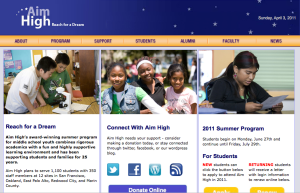It’s Thursday morning in an 8th grade history class at St. Cecilia Middle School. As the teacher discusses a Holocaust survivor who visited the class the day before, four kids giggle quietly. They aren’t laughing at the subject matter, but they are clearly not paying attention either.
Four years ago, Katie Lo could have been one of those kids. But today she sits erect and attentive in class, raises her hand eagerly to answer questions, and reads the assignment instead of chatting.
The difference? Aim High, a five-week summer school program for middle school students. Aim High began on the campus of Lick-Wilmerding High School in San Francisco 25 years ago, and has since expanded to include 11 more Bay Area campuses, including The Urban School. Each summer, roughly 100 middle school students come to Urban to take humanities, math, science, and issues & choices courses.
Katie, tall and thin with long, dark hair, graduated from the program last year as a rising eighth grader after completing the full program, or three summers.
Aim High’s Web site states that Aim High strives to “instill a deep love of learning through an engaging, personalized and supportive summer school program … The majority of the youth … serve(d) come from low-income families, live in under-resourced neighborhoods, and will be the first in their families to graduate from college.”
As of 2009, the most recent figures available, 70 percent of Aim High students were of “poverty or low income level,” 66 percent had a home language other than English, and only 22 percent had a parent who graduated from college. In an interview with the Legend, Alec Lee, Aim High director, said “education is the civil rights issue of our era. Aim High is part of the solution.”
Lee describes how the teachers get as much out of the experience as the students. “Our teachers see the face of the challenge and also play a real role in the solution,” Lee said. “They see a model that works. The teaching assistants have a real voice and get the experience of hands-on teaching and meaningful professional development.”
Thomas Jacquez, Urban Spanish teacher and Aim High Urban site director, says that underprivileged students are meaningfully served in the program. “At the end of each summer we give an exit survey to all of our students,” he wrote in an e-mail. “Ninety-one percent of our Aim High students feel more confident about next year’s schoolwork; 95 percent of Aim High students report that Aim High helped them become more excited about learning new things. Over the course of 5 weeks, Aim High students increased their math assessment scores by 15 percent. On an anecdotal level, when I see our students and staff smiling, I know that we are supporting healthy (relationships) with peers and adults.”
Aim High hires approximately 85 high school students as teaching assistants every year. Most of these are paying jobs, with the exception of rising sophomores, who are considered volunteers.
While teaching for Aim High can be personally rewarding, it can also be challenging professionally. Initially, pupils can be shy and remote. By the end of the program, many are much more comfortable with performing or speaking in front of groups. Says Sophie Lieberman, 2010 Aim High teaching assistant and Urban graduate (’10), “after the five weeks of teaching humanities, I could see the clear improvement in my students’ work – they were writing longer and longer pieces and actually seemed to enjoy and get something out of it.”
For more, click the photo to visit Aim High’s web site.


